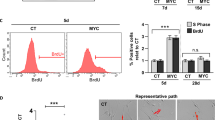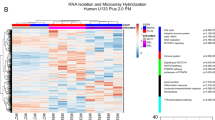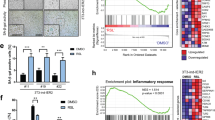Abstract
Induction of irreversible growth arrest and terminal differentiation in human melanoma cells following treatment with recombinant human fibroblast interferon (IFN-β) and mezerein (MEZ) results in elevated expression of a specific melanoma differentiation associated gene, mda-7. Experiments were conducted to define the mechanism involved in the regulation of mda-7 expression in differentiating human melanoma cells. The mda-7 gene is actively transcribed in uninduced HO-1 human melanoma cells and the rate of transcription of mda-7 is not significantly enhanced by treatment with IFN-β, MEZ or IFN-β+MEZ. The high basal activity of the mda-7 promoter in uninduced melanoma cells and the absence of enhancing effect upon treatment with differentiation inducers is corroborated by transfection studies using the promoter region of mda-7 linked to a luciferase reporter gene containing the SV40 polyadenylation signal sequence. RT–PCR analysis detects the presence of low levels of mda-7 transcripts in uninduced and concomitant increases in differentiation inducer treated HO-1 cells. However, steady-state mda-7 mRNA is detected only in IFN-β+MEZ and to a lesser degree in MEZ treated cells. We show that induction of terminal differentiation of HO-1 cells with IFN-β+MEZ dramatically increases the half-life of mda-7 mRNA while treatment with cycloheximide results in detectable mda-7 mRNA in control and inducer treated cells. These observations confirm constitutive activity of the mda-7 promoter in HO-1 cells irrespective of differentiation status suggesting posttranscriptional processes as important determinants of mda-7 expression during terminal differentiation. The 3′ UTR region of mda-7 contains AU-rich elements (ARE) that contribute to rapid mda-7 mRNA turnover during proliferation and reversible differentiation, a process controlled by a labile protein factor(s). Substitution of the SV40 polyadenylation signal sequence in the luciferase reporter plasmid with the mda-7-ARE-3′-UTR renders the Luciferase message unstable when expressed in proliferating and reversibly differentiated melanoma cells. In contrast, the luciferase message is stabilized when the mda-7-ARE-3′-UTR construct is expressed in terminally differentiated HO-1 cells. These results provide compelling evidence that mda-7 expression during terminal differentiation in human melanoma cells is regulated predominantly at a posttranscriptional level.
This is a preview of subscription content, access via your institution
Access options
Subscribe to this journal
Receive 50 print issues and online access
$259.00 per year
only $5.18 per issue
Buy this article
- Purchase on Springer Link
- Instant access to full article PDF
Prices may be subject to local taxes which are calculated during checkout




Similar content being viewed by others
References
Aharon T and Schneider RJ . 1993 Mol Cell Biol 13: 1971–1980
Belasco JG and Higgins CF . 1988 Gene 72: 15–23
Elder PK, Schmidt LJ, Ono T and Getz MJ . 1984 Proc Natl Acad Sci USA 81: 7476–7480
Fisher PB, Prignoli DR, Hermo Jr H, Weinstein IB and Pestka S . 1985 Interferon Res 5: 11–22
Fontes AM, Ito J and Jacobs-Lorena M . 1999 Curr Top Dev Biol 44: 171–202
Goeddel DV, Leung DW, Dull TJ, Gross M, Lawn RM, McCandliss R, Seeburg PH, Ullrich A, Yelverton E and Gray PW . 1981 Nature 5: 20–26
Gopalkrishnan RV, Christiansen KA, Goldstein NI, DePinho RA and Fisher PB . 1999 Nucl Acids Res 24: 4775–4782
Huang F, Adelman J, Jiang H, Goldstein NI and Fisher PB . 1999a Oncogene 18: 3546–3552
Huang F, Adelman J, Jiang H, Goldstein NI and Fisher PB . 1999b Gene 236: 125–131
Huberman E and Callaham MF . 1979 Proc Natl Acad Sci USA 76: 1293–1297
Ishikawa M and Kerbel RS . 1989 Int J Cancer 43: 134–139
Jiang H, Waxman S and Fisher PB . 1993 Mol Cell Different 1: 197–214
Jiang H and Fisher PB . 1993 Mol Cell Different 1: 285–299
Jiang H, Lin J and Fisher PB . 1994 Mol Cell Different 2: 221–239
Jiang H, Lin JJ, Su Z-z, Goldstein NI and Fisher PB . 1995a Oncogene 11: 2477–2486
Jiang H, Lin J, Su Z-z, Kerbel RS, Herlyn M, Weissman RB, Welch D and Fisher PB . 1995b Oncogene 10: 1855–1864
Jiang H, Lin JJ, Su Z-z, Goldstein NI and Fisher PB . 1996 Proc Natl Acad Sci USA 93: 9160–9165
Kang D-c, LaFrance R, Su Z-z and Fisher PB . 1998a Proc Natl Acad Sci USA 95: 13788–13793
Kang D-c, Motwani M and Fisher PB . 1998b Int J Oncol 13: 1117–1126
Krowczynska A, Yenofsky R and Brawerman G . 1985 J Mol Biol 181: 231–239
Linial M, Gunderson N and Groudine M . 1985 Science 230: 1126–1132
Madireddi MT, Su Z-z, Young CSH, Goldstein NI and Fisher PB . 2000 In Cancer Gene Therapy Past Achievements and Future Challenges, Habib N ed. Plenum Publishing Company New York, NY in press
Miller AD, Curran T and Verma IM . 1984 Cell 36: 51–60
Myer VE, Fan XC and Steitz JA . 1997 EMBO J 16: 2130–2139
Nedwin GE, Svedersky LP, Bringman TS, Palladino Jr MA and Goeddel DV . 1985 J Immunol 135: 2492–2497
Patterson A and Harris AL . 1999 Drugs Aging 14: 75–90
Raj NB and Pitha PM . 1981 Proc Natl Acad Sci USA 78: 7426–7430
Rajagopalan LE and Malter JS . 1997 Prog Nucleic Acid Res Mol Biol 56: 257–286
Ross J . 1996 Trends Genet 12: 171–175
Sachs L . 1980 Proc Natl Acad Sci USA 77: 6152–6156
Scott RE and Maercklein PB . 1985 Proc Natl Acad Sci USA 82: 2995–2999
Scott RE . 1997 Pharmacol Ther 73: 51–65
Shaw G and Kamen R . 1986 Cell 46: 659–667
Shyu AB, Belasco JG and Greenberg ME . 1991 Genes Dev 2: 221–231
Spicher A, Guicherit OM, Duret L, Aslanian A, Sanjines EM, Denko NC, Giaccia AJ and Blau HM . 1998 Mol Cell Biol 12: 7371–7382
Su Z-z, Madireddi MT, Lin JJ, Young CSH, Kitada S, Reed JC, Goldstein NI and Fisher PB . 1998 Proc Natl Acad Sci USA 95: 14400–14405
Tamayo P, Slonim D, Mesirov J, Zhu Q, Kitareewan S, Dimitrovsky E, Lander ES and Golub TR . 1999 Proc Natl Acad Sci USA 96: 2907–2912
van Straaten F, Muller R, Curran T, van Beveren C and Verma IM . 1983 Proc Natl Acad Sci USA 80: 3183–3187
Wada RK, Pai DS, Huang J, Yamashiro JM and Sidell N . 1997 Cancer Lett 121: 181–188
Waxman S, Rossi GB and Takaku F . 1991 The Status of Differentiation Therapy of Cancer, Waxman S, Rossi GB and Takaku F eds. Serono Symposia Pubs Raven Press New York
Waxman S . 1995 Differentiation Therapy Waxman S ed Serono Symposium Publications Rome, Italy
Wong GG, Witek JS, Temple PA, Wilkens KM, Leary AC, Luxenberg DP, Jones SS, Brown EL, Kay RM, Orr EC, Shoemaker C, Golde DW, Kaufman RJ, Hewick RM, Wang EA and Clark SC . 1985 Science 228: 810–815
Acknowledgements
We thank Drs S Chellappan and D-c Kang for critically reviewing this manuscript. The present research was supported in part by National Cancer Institute Grant CA35675, the Samuel Waxman Cancer Research Foundation and the Chernow Endowment. MT Madireddi is supported by a fellowship award from the Army Department of Defense Initiative on Breast Cancer (DAMD17-98-1-8503). The V. Foundation, PHS RO1DK52825 and Army DOD BC 98-0148 support P Dent. PB Fisher is the Michael and Stella Chernow Urological Cancer Research Scientist.
Author information
Authors and Affiliations
Rights and permissions
About this article
Cite this article
Madireddi, M., Dent, P. & Fisher, P. Regulation of mda-7 gene expression during human melanoma differentiation. Oncogene 19, 1362–1368 (2000). https://doi.org/10.1038/sj.onc.1203424
Received:
Revised:
Accepted:
Published:
Issue Date:
DOI: https://doi.org/10.1038/sj.onc.1203424
Keywords
This article is cited by
-
Enhancement of recombinant human IL-24 (rhIL-24) protein production from site-specific integrated engineered CHO cells by sodium butyrate treatment
Bioprocess and Biosystems Engineering (2022)
-
Molecular targets and signaling pathways regulated by interleukin (IL)-24 in mediating its antitumor activities
Journal of Molecular Signaling (2013)
-
HDAC4 inhibits the transcriptional activation of mda-7/IL-24 induced by Sp1
Cellular & Molecular Immunology (2010)
-
TRPM1 (Melastatin-1/MLSN1) mRNA expression in Spitz nevi and nodular melanomas
Modern Pathology (2009)
-
The cancer growth suppressing gene mda-7 induces apoptosis selectively in human melanoma cells
Oncogene (2002)



